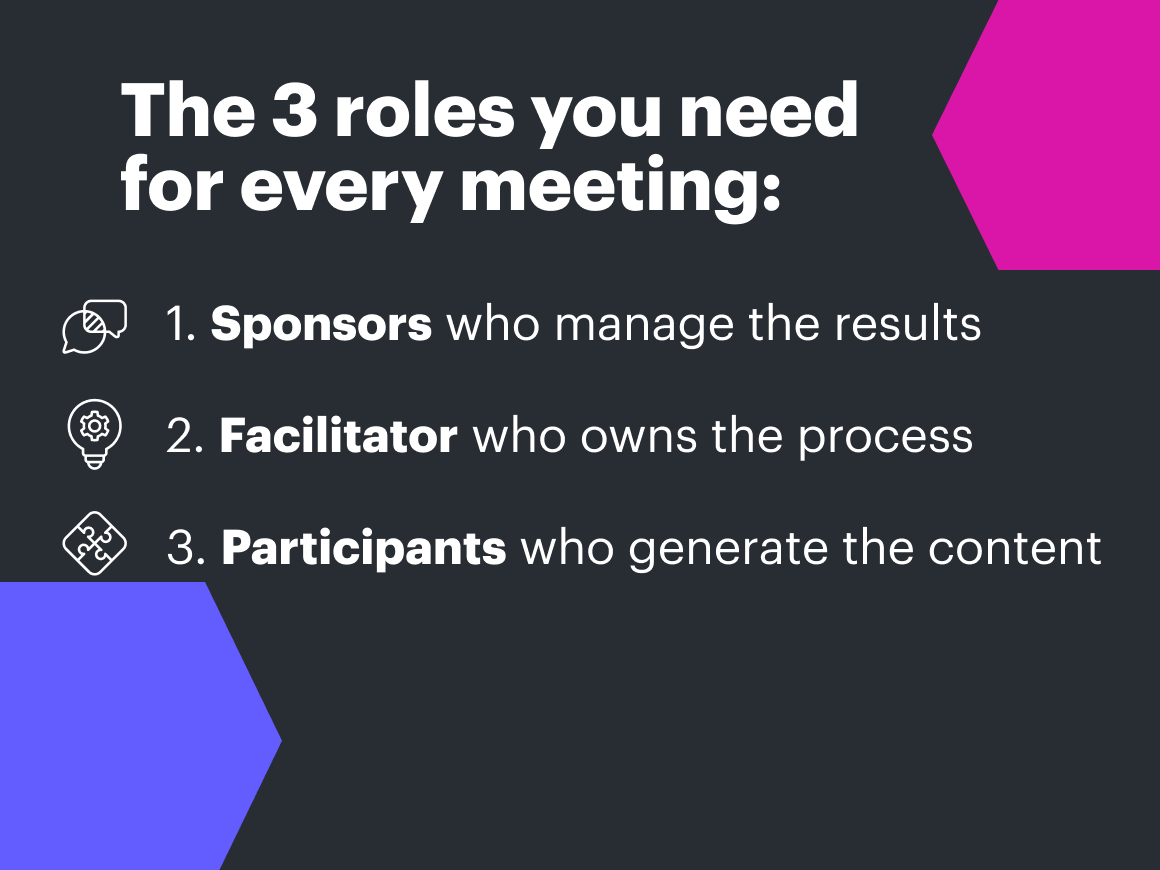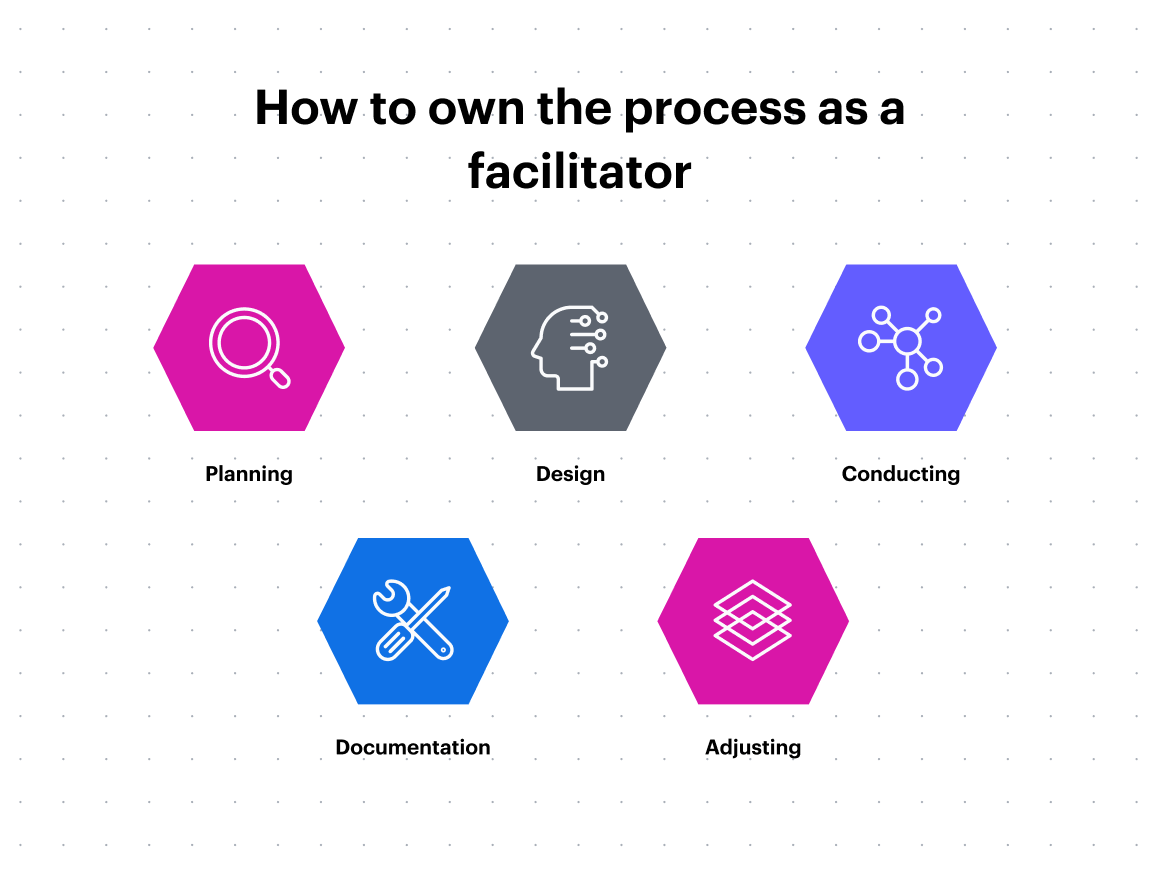
How to facilitate better meetings with Lucid
Reading time: about 12 min
This webinar is adapted from a Lucid webinar, “How to host wildly productive, engaging meetings with Lucid.” You can view the full webinar below:
“This meeting could have been an email.” How often have you heard (or thought) that after a meeting? Our guess is too many times.
Meetings can be extremely valuable in connecting teams, building alignment, and producing innovative ideas and strategies. But the unfortunate truth is that too often, meetings fall short of their promise.
The reasons for this vary:
- A few participants dominate the whole conversation
- Stakeholder needs aren’t heard or met
- Remote and hybrid structures are more distracting
- The discussion lacks direction and focus
- The conversation feels productive, but by the end, you haven’t met your goals
Sound familiar?
Many of these issues aren’t meeting issues at all, they’re actually facilitation issues.
People don’t really think about building rigor into the way they facilitate, but the skill of a facilitator plays a huge role in how successful and productive your meetings are. A good facilitator keeps the discussion on track, ensures balanced participation and input, and helps turn rote checklists into collaborative conversations.
Below we’ll break down how you can improve your facilitation skills to lead more productive meetings that engage your team and drive better collaboration.
1. Knowing your identity and roles
Understanding your role as a facilitator, and that of the other people in the room, is key to leading a successful meeting.
There are three main roles in a meeting:
- Sponsor: Holds the purse strings and is responsible for the results of the meeting.
- Facilitator: Owns and leads the meeting process towards those desired results.
- Participants: Generate the content of the meeting.
“As a facilitator, my role is actually distinct from other people that are there in the room, and if I don't understand that from the very beginning, we’re going to get off on the wrong track,” explains Christopher Bailey, Principal Professional Services Consultant at Lucid.
Bailey recalled experiencing this firsthand when he was asked to facilitate a big brainstorming session for a group of chemists that were trying to come up with new products.
“I barely knew what those words [they were using] meant, and I thought that I was in deep trouble,” he said. “But that was because I misunderstood what my role was…I thought that I also had to own the results of the group and that I had to own the content, that I needed to know enough about chemistry to be able to help that team.”
“Being able to separate that out and say, ‘My role is focusing on the process and how the team is going to get towards better results,” that had a two-prong effect on me. First, it changed the way that I facilitated, but it also helped me to have more confidence jumping into facilitating any kind of conversation, big or small.”

So what makes a strong facilitator?
A facilitator isn’t there to push ideas or be the hero of the discussion. The purpose of your role is to lead the group through the process in a way that encourages collaboration while driving the team to results.
There are a few best practices to follow to keep that facilitator identity clear:
Plan with the results in mind
Facilitators should always have the end results in mind when leading a meeting. If you aren’t working towards those meeting objectives, no matter how interesting the discussion, you won’t have the results you want.
Lean on the sponsor to clarify what outcomes you’re striving for. This will help you keep the discussion focused and efficient.
Ask questions like:
- What does success look like?
- What should we be able to do now that we have made these decisions?
- If we have a successful meeting, what should now happen because of that?
Then, based on those established goals, draft an agenda and create a diverse set of participants who can help get you there.
Pro Tip: Try Lucid’s project planning templates to help you prepare for the meeting—there are dozens to choose from to fit the needs of your meeting. Outline the questions you should ask beforehand and fill in the answers to keep the discussion focused.

Enable the group with the right tools
Preparation leads to better meetings. Make sure your group has the information and tools they need to come prepared. This includes drafting and sharing an agenda with the purpose and goals of the meeting clearly outlined. Be sure to share any other resources or information ahead of time so you aren’t using time during the meeting to go over materials.
Pro Tip: Take advantage of asynchronous collaboration tools like Lucid to share and communicate meeting information before and after the meeting all in one place.

Check our toolkit of templates for mastering asynchronous work using visual collaboration.
Read onCreate safety throughout
As a facilitator, your primary identity is to be an advocate for people—to create a safe space for everyone to share and collaborate effectively. That means making sure each person has a chance to contribute or maintaining rules of engagement when the conversation veers off track.
To create safety, it’s important to come to the meeting assuming people’s good intentions. Building a conversation from that foundation allows everyone to operate in good faith and collaborate constructively.
Establish clear rules of engagement upfront (document them in a working agreement with the team) and use that as a reference as needed. This will help you maintain a neutral position as you maintain those boundaries and drive the conversation forward.
Pro Tip: Get everyone on the same page by building a meeting agenda in Lucidspark. In addition to the content of the meeting, you can also discuss as a group what norms or rules of engagement you want to follow. This document will serve as a shared reference you can point to as needed to diffuse conflict and maintain focus.

2. Owning the process
As a facilitator, you aren’t responsible for owning the ideas—but you are in charge of managing the process to get the group to their final outcomes. This process includes five high-level steps:
- Planning: Define what success is (and how you’ll know it when you see it).
- Design: Establish opportunities for collaboration end goal in mind.
- Conduct: Focus and move the group toward the desired results.
- Documentation: Keep a record of decisions made to help the team stay aligned.
- Adjusting: Review results and improve or repeat processes as needed.
Planning and design
Planning and design come ahead of the meeting. These steps are crucial for laying the groundwork for a successful discussion. Then when you conduct a meeting, you are putting those plans into action to keep the group focused and moving towards the stated goals.
“When you're thinking about designing, focus on creating a visual flow and structure with the activities and the outcomes that is easy for people to follow,” said Torrie Foutz, Learning Experience Design Manager at Lucid.

Your meeting design should be “explanation proof,” meaning the activities on the agenda are clear, simple, and self-explanatory.
You can do this seamlessly in Lucidspark. For example, starting with a “climate setter” or icebreaker to get the team warmed up, you can then lead participants along the paths to other frames like the working agreement and goals, and then along divergent and convergent exercises to gather ideas and then align on what resonates most.
Balancing divergent and convergent thinking helps you gather a wide variety of ideas (quantity over quality) and then narrow them down to the best, most actionable items.

Explore a variety of Lucidspark icebreaker activities in our template library to get your team off on the right foot.
See moreConduct
The next step is conducting the meeting. If you do nothing else, it’s essential to keep the group focused on the outcomes. In a group setting, it's all too easy for the discussion to veer off-road. Your job as facilitator is to redirect the discussion back towards the objectives and communicate those outcomes frequently so everyone is on the same page.
There are a few things you can do to help:
- Keep the timer visible to everyone. Adding a timer to your collaboration page keeps people accountable to the time and pushes creativity within that constraint.
- Put off-topic thoughts in the “parking lot.” You’ll likely end up with a lot of extra ideas that don’t quite fit the objectives you’re aiming for. Instead of discarding them, move them to a “parking lot” container where you can revisit them later.
- Confirm progress toward the outcome with your sponsor. Check in with the sponsor throughout the meeting to make sure you are headed in the right direction and that you are still clear on the outcomes.
- End with next steps and who owns what. Finally, don’t forget to document and communicate next steps and ownership for action items following the meeting. You don’t want to facilitate a great meeting and then never do anything with the information.
Pro Tip: Add a timer to any of your creative sessions directly in your Lucidspark board. And use frames to create brainstorming spaces for your ideas, including a designated parking lot.

Document and adjust
At the end of the process, document decisions and assess how the meeting went.
Consider the following questions:
- Are we getting what I need from these sessions?
- Are we aligned?
- Do we need to have more of these meetings?
- What should this meeting look like moving forward?
Based on your retrospective, identify proven processes from the meeting and templatize those so you can replicate them in future sessions.
Then communicate the project status regularly, sharing documentation where your team gathers frequently. This can be in a group Slack channel, a project management system, or directly on your Lucid board. You can also comment and tag team members in Lucid, and import data right to your shared board.
Pro Tip: Use Lucid retrospective templates to guide your assessment and document your analysis.

3. Supporting collaboration
Unfortunately, getting people together in a room with an agenda isn’t enough to spark effective collaboration. That’s where the facilitator comes in.
“As a facilitator, because you're not as responsible for the ideas and you're a bit more removed, you're able to focus on helping the group navigate conflict,” said Morgan Skidmore, Learning Experience Designer at Lucid.
“You can see when there's a little bit of tension, you can maintain collaborative equity, and if you're sensing that people are confused, you can provide clear instructions and manage the energy of the group.”
Establish collaborative equity
“Collaborative equity is about providing ample opportunities for each participant to contribute in the way that they're most comfortable with,” said Skidmore. “So again, as the facilitator, it's just about being intentional and creating lots of options for how to engage.”
To create collaborative equity, get to know your team’s collaboration styles.

Get our guide to understanding the three collaboration styles—with templates best fit for each.
Read now“This one is huge for me,” said Foutz. “My collaboration style is very different from my manager's, but he knows my collaboration style. He knows that I like to be prepared, so he will give me a heads up if we're having a big brainstorm and share the outcomes, so I can do a bit of research prior to coming to the meeting. That has been a game changer for how we work as a team, how I show up in those meetings, and how he supports me.”
With those styles in mind, you can better design your group of participants to create a balanced team of perspectives and approaches. And you’ll be better prepared to facilitate those styles effectively.
Other ways to build collaborative equity include:
- Incorporating visuals as a means of participation: This is especially helpful for more introverted personalities and those who like to write out their thoughts.
- Appointing an advocate to help facilitate participation: This is great for hybrid and remote meetings where it’s easy for people to hang out in the background. For example, if you’ve had a lot of input from people in person, you can turn to your advocate to pull in voices from the remote side.
- Getting input in a variety of ways: With Lucid’s Visual Activities functionality, you can quickly gather qualitative input from a group that you can use to drive decisions forward, while still accommodating those who might not want to speak up as much during meetings. This helps ensure everyone has a chance to participate comfortably and fairly.

Pro Tip: Use color coding in Lucid to make it easy to see who is commenting. This helps track participation at a glance and streamlines communication after the meeting so participants can refer back to ideas and feedback with clarity on who contributed what.
Provide focused bursts of energy
“If you're noticing that the energy of your group is going down, there are lots of energy starters that you can do to break the cadence of the meeting and shake things up,” said Skidmore.
These are great at the start of meetings and during breaks to re-energize the group.
Use visuals to reach consensus quickly
Visuals can be a great shorthand for getting feedback from the group quickly.
For instance, a quick round of “fist of five” can give you non-verbal, visual cues of how people are feeling about a certain decision or even the group’s energy level. Simply have participants hold up their fingers on a scale of 1-5 to rate their reactions. So a five could be “I’m feeling great; I’m invested in this idea,” and a one is “I need more discussion.”

Additionally, use your visual whiteboard to capture and record ideas people are excited about. Have people write down their own thoughts to keep them engaged in the process. As you gather more ideas, take time to discuss and vote on decisions as a group.
Pro Tip: Lucid’s voting feature allows you to create and facilitate voting sessions right on the board. You can select which items you want the team to vote on, set a timer for how long people have to submit their votes and assign a number of votes to each participant. This makes it easy for people to participate in decision-making during a meeting or in between meetings on their own time.

Great facilitators aren’t born, they’re made. Deepen your facilitation skills with our Lucid Creative Facilitation badge.
Get the badgeAbout Lucid
Lucid Software is a pioneer and leader in visual collaboration dedicated to helping teams build the future. With its products—Lucidchart, Lucidspark, and Lucidscale—teams are supported from ideation to execution and are empowered to align around a shared vision, clarify complexity, and collaborate visually, no matter where they are. Lucid is proud to serve top businesses around the world, including customers such as Google, GE, and NBC Universal, and 99% of the Fortune 500. Lucid partners with industry leaders, including Google, Atlassian, and Microsoft. Since its founding, Lucid has received numerous awards for its products, business, and workplace culture. For more information, visit lucid.co.